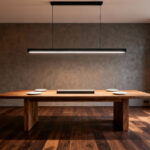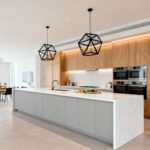You know what people always ask me? It’s not “What art should I buy?”—not at first. It’s a much more vulnerable question: “Where do I even start?” They stand in their bedroom, surrounded by blank walls, feeling totally overwhelmed. They see all these perfect rooms on Pinterest and feel paralyzed, thinking they need a massive budget and a design degree to create a space that feels like them.
That’s the biggest myth out there. Your walls aren’t a test you can fail. They’re a story you get to tell. A home that reflects you isn’t about following rules; it’s about listening to your own intuition and learning a few tricks of the trade to translate that feeling into something you can see and touch. As a curator, my job has always been to find the story in the art and arrange it so that it speaks to you. Your home is no different.
So let’s cut through the noise. Here are 20 ways to think about your bedroom walls, from the foundational groundwork to the pro-level techniques that will make your space feel like a true sanctuary.
Laying the Groundwork: Strategic Planning for Wall Decor
Before you even think about picking up a hammer, a little soul-searching and strategy will save you so much time, money, and regret. These first few steps are the un-sexy but essential foundation for creating a room that feels cohesive and deeply personal. Get this right, and everything else falls into place.
1. Define Your Personal Bedroom Style for Cohesive Decor
Can we talk about why everyone gets this wrong? They chase trends. I once had a client who bought a very expensive, very trendy piece of neon art because she saw it everywhere. She hated it. It buzzed, it felt jarring, and it gave her zero sense of peace. The problem wasn’t the art; it was that she never stopped to ask herself what she actually wanted to feel in her room. Forget what’s in magazines. Your style is a feeling first, and a look second. Do you want to feel calm? Energized? Cozy? Enveloped? Start there.

Your first move is to create a visual diary, not just a mood board. Pin things that make you feel good, even if you don’t know why. A landscape photo from a trip, the texture of a knitted sweater, the color of a moody sky. After a week, look at it. You’ll see patterns. Maybe it’s all earthy tones and natural textures. Maybe it’s clean lines and soft, muted colors. Distill that feeling into three words. ‘Serene, organic, soft.’ or ‘Dramatic, cozy, eclectic.’ Those are your North Stars. They’ll guide every decision and stop you from buying that neon sign you’ll regret.
Now that you have your stylistic “keywords,” let’s make sure the art you choose actually fits your space.
2. Accurately Measure Wall Dimensions for Perfect Sizing
This is the most boring tip on the list, and also the one that will save you the most money and frustration. I can’t tell you how many times people have bought a piece of art, brought it home, and discovered it looks like a tiny postage stamp on a giant wall, or it’s so massive it completely suffocates the room. Eyeballing it is a recipe for disaster. It’s the art-world equivalent of “measure twice, cut once,” and it’s non-negotiable.

Here’s the shortcut you need: blue painter’s tape. Once you’ve measured your wall, use the tape to create a to-scale outline of the artwork or gallery wall you’re considering. Live with that blue rectangle for a few days. Does it feel right above your bed? Does it leave enough breathing room? This simple trick gives you a real-world feel for scale and proportion before you spend a dime or put a single hole in the wall. It’s a game-changer for getting the size just right.
With your measurements handled, we can move on to the most transformative element of all: color.
3. Choose a Calming Wall Color Palette for Restful Sleep
I used to think color was simple. Then I painted my own bedroom what I thought was a “calming, soft gray.” In the tiny swatch at the store, it looked perfect. On my walls? It turned into a sad, depressing lilac depending on the light. I learned the hard way that a wall is a giant light reflector, and the color you choose will look completely different at 8 AM than it does at 8 PM under lamplight. Choosing a “calming” color is less about the specific hue and more about how that hue behaves in your space.

The real key is to focus on muted, nature-inspired tones. Think about the colors of a foggy morning, a dusky sky, or a mossy forest floor—blues, greens, grays, and warm beiges that have a bit of softness to them. Avoid anything too pure or vibrant. But most importantly, get large sample swatches and paint them on at least two different walls. Live with them for a full weekend. Watch how the morning sun hits them, how they look in the afternoon, and how they feel at night. A color that holds its sense of calm through all those changes is your winner.
Now that the room has the right mood, it’s time to decide where to focus all this beautiful energy.
4. Identify Your Room’s Natural Focal Wall for Maximum Impact
Everyone thinks they need to decorate all four walls equally. You don’t. That’s how a room starts to feel cluttered and chaotic. The secret to a high-impact space is to put your energy and your best pieces on the focal wall. So, what is it? It’s simply the wall your eyes land on the moment you walk into the room. Nine times out of ten, it’s the wall your bed is on. It’s the natural star of the show.

Don’t overthink it. Do the “Instagram test.” Stand at the doorway of your bedroom and pull out your phone as if you’re about to take a picture. The view that feels like the most natural, compelling shot? That’s your focal wall. By concentrating your main design elements there—whether it’s a statement piece of art, a gallery wall, or a textured finish—you create a powerful anchor for the entire room. The other walls can be quieter; their job is to support the star.
You’ve found your stage. Now let’s talk about the budget for the performance.
5. Set a Realistic Wall Decor Budget for Smart Financial Choices
The idea that you need to be rich to have a home full of meaningful art is complete BS. I’ve seen more soul and style in homes decorated with thrift-store finds and personal photos than in sterile mansions full of expensive-but-soulless “decorator art.” Setting a budget isn’t about limiting yourself; it’s about getting creative. It forces you to think about what really matters and where your money will make the biggest impact.

My favorite approach is what I call the “Splurge, Save, and Scour” method.
- Splurge: Allocate a decent chunk of your budget for one piece that you absolutely, unequivocally love. Maybe it’s a large-scale print from an artist you follow, or custom framing for a piece you already own. This is your anchor.
- Save: Fill in the gaps with affordable options. Think high-quality digital prints from places like Etsy, or your own photography printed beautifully.
- Scour: This is the fun part. Hunt through flea markets, antique shops, and even your parents’ attic for frames, small objects, and unique pieces with a story. This is how your walls get character that no one can replicate.
Core Wall Art & Design Techniques for Bedrooms
With the planning done, it’s time for the fun part: bringing your walls to life. These are the core techniques I turn to again and again to create rooms that feel curated, personal, and complete.
6. Master Gallery Wall Layouts for Visual Harmony
My biggest pet peeve? Gallery walls that look like a random explosion of stuff. A great gallery wall isn’t just a collection of pictures; it’s a conversation. All the pieces should be talking to each other. The secret is finding a common thread. It could be a consistent color palette (like all black-and-white photos), a common theme (like travel), or a unified frame style (like all simple, natural wood frames). This thread is what holds the entire arrangement together and keeps it from looking like clutter.

Before you make a single hole in the wall, lay everything out on the floor. Play with the arrangement. The shortcut I swear by is to trace each frame onto kraft paper, cut out the templates, and tape them to the wall. You can move them around, see the spacing, and perfect the composition without any commitment. As a general rule, start with your largest piece in an off-center position and build out from there. It feels more organic and dynamic.
Or, if a whole wall of art feels too busy for you, maybe it’s time to think bigger.
7. Incorporate Large-Scale Art as a Powerful Statement Piece
Sometimes the most powerful thing you can do is say one thing, very clearly. A single, oversized piece of art is the definition of confidence. It can anchor a room, set the tone, and create a “wow” moment all by itself. I learned this the hard way in my first apartment. I spent months trying to fill a huge blank wall with a mishmash of small prints and photos, and it just looked nervous and cluttered. A friend, an artist, finally told me, “Alex, just commit. Get one big piece you love.” I saved up, bought a huge abstract canvas, and the room instantly felt finished.

The only rule here is to go bigger than you think you should. A common mistake is buying art that’s too small for the furniture it’s hanging over. As a guideline, a piece of art above a bed or a sofa should be at least two-thirds the width of the furniture. Don’t be afraid to let it dominate. That’s the whole point. A bold, large-scale piece is an investment in simplicity and impact, making your decorating job so much easier because it does all the heavy lifting.
If a huge piece of art isn’t in the budget, there’s another way to make a big, bright statement.
8. Strategically Place Mirrors to Expand Space and Light
Mirrors are magic. They’re the oldest trick in the design book for a reason. But most people just hang one over a dresser and call it a day. A curator thinks of a mirror as an artist’s tool. It’s not just a reflection; it’s a way to manipulate light and space. Placing a large mirror opposite a window essentially creates a second window, doubling your natural light and bringing the outdoors in. It’s the single best thing you can do to make a small, dark room feel bigger and brighter.

But here’s the pro move: be intentional about what it reflects. Angle it to catch a view of your favorite painting on the adjacent wall, or a beautiful chandelier, or the green leaves of a plant. Don’t let it reflect the doorway to a messy bathroom or a cluttered corner. A mirror amplifies whatever is in front of it, for better or for worse. Use it strategically to double down on the beauty you’ve already created, and your room will instantly feel more expansive and full of light.
Next, let’s talk about adding a sense of touch to your walls.
9. Introduce Rich Textures with Fabric Panels or Wallpaper
A room isn’t just something you see; it’s something you experience. Texture is how you engage the sense of touch, even from across the room. A wall covered in grasscloth, linen, or even a soft, chalky limewash paint invites you in. It adds a layer of warmth and sophistication that flat paint just can’t replicate. It says, “this is a soft place to land.” This is especially powerful in a bedroom, where you want everything to feel cozy and cocoon-like.

Beyond the visual warmth, textured walls have a practical secret: they absorb sound. In a room with hardwood floors and lots of hard surfaces, sound can bounce around and feel harsh. A textured wall—especially one with a textile-based wallpaper or fabric panels—dampens that echo, making the room feel quieter and more serene. It’s a subtle but powerful way to enhance the feeling of sanctuary.
From the purely tactile, let’s move to something that’s both beautiful and incredibly useful.
10. Utilize Floating Shelves for Stylish Display and Storage
Think of floating shelves less as storage and more as a stage. They are the perfect way to create little curated moments, or “vignettes,” on your walls. The mistake people make is cramming them full of stuff. A floating shelf is not a bookshelf. Its purpose is to elevate a few select objects, turning them into a small-scale art installation. A beautiful ceramic vase, a small stack of inspiring books, a framed photo, and a tiny plant—that’s a composition.

The secret to styling them is to think like a curator. Vary the height and texture of your objects. Work in odd numbers, like groups of three or five, which is more visually pleasing to the eye than even numbers. And most importantly, leave some negative space. Let the objects breathe. This approach transforms a functional shelf into a piece of decor in its own right, adding personality and a focal point without taking up any floor space.
Speaking of personal touches, let’s make it explicitly about you.
11. Personalize Walls with Thoughtfully Curated Photo Displays
Your story is the most important art you can own. A wall of personal photos grounds your space in who you are and what you love. But a mishmash of mismatched frames from the last 20 years can quickly look chaotic. The secret to making a photo display feel intentional and chic is to create cohesion. The easiest way to do this is to print all your photos in black and white. It instantly unifies different eras, locations, and photo qualities into a single, artful story.

Another shortcut is to unify the frames. They don’t have to be identical, but they should share a common element—all black, all natural wood, or all thin gold metal, for instance. And don’t just stick to photos. Weave in a small postcard, a child’s drawing, a ticket stub from a meaningful event. These are the artifacts of your life. By curating them with a consistent visual element, you elevate your personal memories into a true work of art.
Now, let’s talk about going big with a single, dramatic move.
12. Design a Dramatic Accent Wall for Immediate Visual Impact
The accent wall got a bad rap for a while because people were just slapping a single coat of “burgundy red” on one wall and calling it a day. But a truly dramatic accent wall, done right, is a showstopper. Think beyond just a coat of paint. I’m talking about a wall of rich, dark wood slats that add incredible texture and depth. Or a bold, large-scale floral or geometric wallpaper that turns the wall itself into a mural. Or even a hand-troweled plaster or concrete finish that gives it an ancient, earthy texture.

The key is commitment. An accent wall should be the undeniable focal point—the wall behind your bed is the perfect candidate. It provides the backdrop and sets the entire mood for the room. When you go for a truly bold statement on one wall, you can keep the rest of the room relatively simple. The accent wall does all the talking, creating a huge amount of drama and personality with a single, powerful decision.
Beyond Art: Functionality and Dimensionality on Walls
Great wall design isn’t just about what you hang on them. It’s about using the walls themselves to shape the light, sound, and even the air in your room. These next ideas bridge the gap between aesthetics and function.
13. Integrate Ambient Wall-Mounted Lighting for Mood Setting
Let me tell you, wall sconces are not just for fancy hotels. They are one of the most underrated tools for creating a sophisticated and relaxing atmosphere in a bedroom. Table lamps are fine, but they take up precious space on your nightstand and create isolated pools of light. Wall-mounted sconces, on the other hand, wash the wall with a soft, ambient glow. This makes the room feel larger, eliminates harsh shadows, and instantly creates a more serene, high-end vibe.

The real magic happens when you put them on a dimmer switch. This is non-negotiable. It allows you to have bright, functional light when you need it for reading, and a soft, warm, barely-there glow when you’re winding down. I recommend choosing fixtures with a warm light temperature (around 2700K) to promote relaxation. This isn’t just decoration; it’s designing your own light to support your own well-being. It’s a functional sculpture.
For those who aren’t ready to hardwire lighting, here’s a less permanent way to make a big change.
14. Explore Removable Wall Decals for Rental-Friendly Decor
If you’re a renter or just a bit of a commitment-phobe, removable decals are your best friend. But please, let’s move beyond the cheesy “Live, Laugh, Love” quotes. The world of removable wall decor has gotten incredibly sophisticated. You can find stunning, large-scale abstract shapes, intricate botanical designs, and full-on murals that look like custom wallpaper but peel right off without a trace when you’re ready to move. It’s art for people who like to change their minds.

The trick is to look for high-quality vinyl or fabric decals, as they have a more matte, paint-like finish and are less likely to damage your walls. Use them to create a focal point behind your bed, or to add a splash of pattern to a small nook. It’s a low-cost, zero-risk way to experiment with a bold look you might not be ready to commit to with paint or real wallpaper. Think of it as a trial run for a bolder you.
From temporary patterns to something truly alive, let’s bring some nature indoors.
15. Incorporate Living Greenery with Vertical Planter Walls
Why hang a picture of nature when you can hang nature itself? A living wall is a breathtaking statement piece. It’s a living, breathing sculpture that purifies your air, adds a vibrant splash of color, and connects you to the natural world. In a bedroom, this biophilic connection—our innate desire to be around living things—is incredibly calming and grounding. It can turn your room into a lush, jungle-like escape.

You don’t need a complex, professionally installed irrigation system to make this happen. There are many fantastic modular wall planter systems that are easy to install and maintain. Choose low-maintenance, air-purifying plants like pothos, snake plants, or philodendrons that can thrive in indoor light. A living wall isn’t just decor; it’s a dynamic element that changes and grows with you, bringing life and vitality directly into your sanctuary.
Now, let’s get ruthlessly practical and talk about clearing the decks.
16. Maximize Small Spaces with Elegant Wall Storage Units
Clutter is the enemy of calm. You can have the most beautiful art in the world, but if it’s surrounded by piles of stuff, the room will still feel chaotic. Smart wall storage isn’t just about hiding your things; it’s about creating a clean canvas so your beautiful objects and art can actually shine. By getting things up off the floor and onto the walls, you create visual breathing room, making the entire space feel larger and more serene.

Think about a system of sleek, modern cabinets that blend right into the wall, or a tall, elegant wall-mounted unit that combines closed and open storage. The goal is to make the storage feel like an intentional piece of architecture, not a clunky afterthought. When your storage is as beautiful as your decor, it adds to the aesthetic instead of detracting from it, giving you the best of both worlds: a place for everything and a deeply peaceful space.
Finally, let’s address an invisible element that has a huge impact on how a room feels.
17. Apply Acoustic Wall Panels for Enhanced Room Acoustics
Have you ever walked into a room that just felt quiet? It’s a luxurious feeling, and it’s often due to acoustics. In our modern homes with hard floors and minimal soft furnishings, sound bounces around, creating a subtle but persistent sense of agitation. Acoustic panels are designed to absorb that sound, deadening echo and creating a sense of profound calm. It’s one of those “you don’t know you need it until you have it” upgrades that makes a world of difference in a bedroom sanctuary.

Forget the fuzzy gray squares you see in recording studios. Today, acoustic panels come in beautiful designs that look like art themselves. You can get panels wrapped in gorgeous fabrics, or sleek wood-slat panels that add a warm, Scandinavian touch. Installing them on the wall behind your bed or opposite a major sound source (like a window) can dramatically reduce echo and outside noise, wrapping you in a cocoon of quiet.
Advanced Concepts: Elevating Aesthetics and Harmony
You’ve got the basics down. Now, let’s layer in the sophisticated techniques that take a room from “nicely decorated” to “artfully curated.” This is where you really start playing with dimension and story.
18. Create Depth and Interest with Layered Wall Decor
This is one of my favorite curatorial techniques, and it’s surprisingly easy to do at home. Instead of just hanging things side-by-side, start thinking in three dimensions. Layering is about creating visual depth by placing objects in front of one another. Lean a tall mirror against the wall, and then hang a smaller, framed piece of art so it slightly overlaps the mirror’s edge. Or, hang a large, unframed canvas, and then mount a shallow floating shelf across the bottom third of it to hold a few small objects.

This technique instantly makes a wall feel more dynamic and collected over time. It breaks the flat plane of the wall and invites your eye to travel in and around the composition. It creates a rich, complex visual story that feels much more personal and interesting than a simple, one-dimensional arrangement. Play with it. It’s how you get that effortlessly chic, “I just threw this together” look that is, in fact, incredibly intentional.
From a layered look to a unified story…
19. Curate a Thematic Wall Display for Unique Character
This is where you truly become the curator of your own life. A thematic wall is more than just a gallery wall; it’s a focused exhibition on a single subject that you love. Think of it as telling a story on your wall. Perhaps it’s a “Traveler’s Wall,” with a mix of your own photos, a vintage map of a favorite city, a few framed postcards, and some small objects you collected on your journeys. Or maybe it’s a “Botanical Wall,” with pressed-leaf art, vintage floral prints, and a shelf of small succulents.

The key is to pick a theme that deeply resonates with you and then gather a diverse collection of objects that speak to that theme. Vary the scale, texture, and medium, but keep the story consistent. This transforms a simple wall into the heart of the room—a powerful reflection of your passions and your history. It’s the ultimate form of personalization, creating a space that could belong to no one else but you.
And now for the final touch that brings everything together in perfect balance.
20. Balance Visual Weight to Achieve Overall Room Harmony
Visual weight is the invisible force in a room. It’s the perceived “heaviness” of an object. A large, dark-wood armoire has a lot of visual weight. A small, leggy side table in a light color has very little. A room feels harmonious when this visual weight is balanced. If you have your big, heavy bed and headboard on one side of the room, and nothing but a blank wall on the other, the room will feel lopsided and unsettled.

To create balance, you need to place something of similar—but not identical—visual weight on the opposite side. This doesn’t mean you need another huge piece of furniture. A large piece of bright, compelling art or a well-composed gallery wall can have just as much visual weight as a dresser. The goal is to create a sense of equilibrium, so your eye can move around the room comfortably without getting “stuck” in one heavy corner. Step back, squint your eyes, and trust your gut. If it feels balanced, it probably is.
Conclusion
The biggest takeaway here is to see your walls as an opportunity, not an obligation. They are canvases for your story. You don’t need to tackle all 20 of these ideas at once. Start with one. Find your three style words. Put up some painter’s tape to visualize a piece you love. Buy one great sample pot of paint and live with it for a week.
Art is a conversation, and your home is the most intimate gallery you’ll ever have. Let it be filled with things that make you feel rested, inspired, and deeply, truly yourself. Trust your instincts, start small, and enjoy the process of creating a sanctuary that is yours and yours alone.






